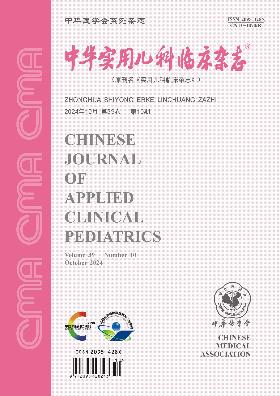血清高迁移率组box 1水平与儿童热性惊厥及未来癫痫发作的关系
Q4 Medicine
引用次数: 0
摘要
目的探讨血清高迁移率群盒1 (HMGB1)水平与儿童热性惊厥(FC)及未来癫痫发作的关系。方法选取2014年1月~ 2017年1月在河南省人民医院儿科就诊的首发FC患儿359例作为FC组。无FC患儿100例作为发热对照组,健康患儿100例作为健康对照组。对患有FC的儿童进行了18个月的随访,并记录了他们的癫痫发作情况。检测所有受试者血清HMGB1及炎症反应指标,分析HMGB1对FC的诊断价值。其他数据用于分析HMGB1与FC转化为癫痫的相关性。结果FC组血清HMGB1水平高于正常对照组和发热对照组,差异均有统计学意义[(3.04±1.01)μg/L,(5.09±1.45)μg/L vs(8.32±2.27)μg/L,均P<0.01]。FC患儿血清HMGB1水平与白细胞介素(IL)-1β、IL-6、肿瘤坏死因子(TNF)-α、c反应蛋白(CRP)、白细胞(WBC)呈正相关(r=0.364、0.173、0.227、0.235、0.247,均P<0.05)。不同惊厥持续时间和类型组间HMGB1水平差异有统计学意义[(8.11±2.15)μg/L vs(10.19±2.51)μg/L,(7.63±1.93)μg/L vs(9.83±2.25)μg/L,均P<0.05];HMGB1水平对FC的诊断效果较好[受试者工作特征曲线下面积(AUC)=0.843 (95% CI: 0.811-0.873)];癫痫合并FC患儿血清HMGB1高于未转化为癫痫患儿,差异有统计学意义[(8.18±2.14)μg/L vs(8.95±2.73)μg/L, P<0.05];然而,其预测FC转化为癫痫的效果不高[AUC=0.596 (95% CI: 0.544-0.691)];多因素回归分析显示,这不是FC对癫痫的独立影响因素[奇比(OR)=1.929, P=0.222]。结论FC患儿血清HMGB1水平与发热的发病、严重程度、类型有关,是FC向癫痫转化的影响因素之一,但不是独立因素。关键词:热惊厥;癫痫;炎症反应;高机动性组箱1本文章由计算机程序翻译,如有差异,请以英文原文为准。
Relationship between serum high mobility group box 1 level and febrile convulsion in children and epileptic seizures in the future
Objective
To investigate the relationship between the serum high mobility group box 1 (HMGB1) level and children with febrile convulsion(FC) and epileptic seizures in the future.
Methods
A total of 359 children with first-episode FC occurring in January 2014 to January 2017 admitted to the Department of Pediatrics, Henan Provincial People′s Hospital, were enrolled in the FC group.One hundred children without FC were enrolled in the fever control group, and 100 healthy children were enrolled in the healthy control group.Children with FC were followed for 18 months and their seizures were recorded.Serum HMGB1 and inflammatory response indexes were measured in all subjects, and the diagnostic value of HMGB1 for FC was analyzed.Other data were used to analyze the correlation between HMGB1 and the conversion of FC into epilepsy.
Results
The level of serum HMGB1 in the FC group were hig-her than those in the healthy control group and the fever control group, and the differences were statistically significant [(3.04±1.01) μg/L, (5.09±1.45) μg/L vs.(8.32±2.27) μg/L, all P<0.01]. serum HMGB1 level in children with FC was positively correlated with interleukin(IL)-1β, IL-6, tumor necrosis factor (TNF)-α, C-reactive protein (CRP) and white blood cell (WBC) (r=0.364, 0.173, 0.227, 0.235, 0.247, all P<0.05). There were significant differences in HMGB1 levels between groups with different duration and types of convulsions [(8.11±2.15) μg/L vs.(10.19±2.51) μg/L, (7.63±1.93) μg/L vs.(9.83±2.25) μg/L, all P<0.05]; HMGB1 level diagnosis of FC was better [area under the receiver′s operating characteristic curve (AUC)=0.843 (95% CI: 0.811-0.873)]; Serum HMGB1 in children with epilepsy with FC was higher than that without conversion to epilepsy, and the difference was statistically significant [(8.18±2.14) μg/L vs.(8.95±2.73) μg/L, P<0.05]; However, its performance in predicting the conversion of FC to epilepsy was not high [AUC=0.596 (95% CI: 0.544-0.691)]; Multivariate regression analysis showed that it was not an independent influencing factor of FC to epilepsy [odd ratio(OR)=1.929, P=0.222].
Conclusions
Serum HMGB1 levels in children with FC are related to the onset, severity and type of fever, and are one of the influencing factors affecting the conversion of FC to epilepsy, but not the independent factors.
Key words:
Febrile convulsion; Epilepsy; Inflammatory response; High mobility group box 1
求助全文
通过发布文献求助,成功后即可免费获取论文全文。
去求助
来源期刊

中华实用儿科临床杂志
Medicine-Pediatrics, Perinatology and Child Health
CiteScore
0.60
自引率
0.00%
发文量
14243
期刊介绍:
Chinese Journal of Applied Clinical Pediatrics ( semi-monthly ) is a core journal of paediatrics under the supervision of China Association for Science and Technology, sponsored by Chinese Medical Association and undertaken by Xinxiang Medical College. Founded in 1986, it is openly circulated both at home and abroad. The journal has several columns, such as Expert Forum, Experimental Research and Paediatric Surgery, which are mainly for paediatric medical workers and medical researchers in hospitals. Its purpose is to reflect the new theories and technologies in paediatric medicine and scientific research at home and abroad, and to promote academic exchanges.
Chinese Journal of Applied Clinical Pediatrics is a source journal of China Science Citation Database (CSCD), a core journal of Peking University, a source journal of Chinese science and technology paper statistics (China Science and Technology Core Journals), a core academic journal of RCCSE, a high-quality scientific and technical journal of China, a high-quality scientific and technical journal of China Association for Science and Technology, and a high-quality scientific and technical journal of China Biomedical Science and Technology Association. We have been published in China Biomedical Literature Database (SinoMed), China Knowledge Network, Wanfang Data Knowledge Service Platform, China Academic Journal Abstracts, Scopus Database, Chemical Abstracts (USA), Japan Science and Technology Agency (JSTA) Database, Copernicus Abstracts (Poland), Abstracts of the Centre for Agricultural and Biological Sciences (CABS) of the United Kingdom, Cambridge Scientific Abstracts ProQuest Database, WHO Medical Journal of the Western Pacific Region (WMPR), and WHO Medical Journal of the Western Pacific Region (WMPR) of the United States. We have been included in dozens of authoritative databases at home and abroad, such as WHO Western Pacific Region Index of Medicine (WPRIM), Ullrich's Guide to Periodicals, and so on.
 求助内容:
求助内容: 应助结果提醒方式:
应助结果提醒方式:


